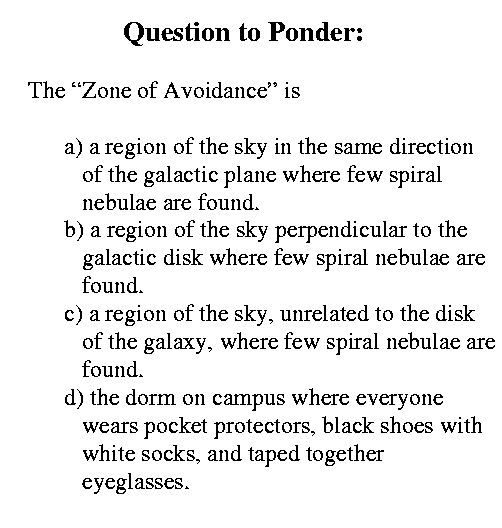|
|
.. the spheres're in commotion the elements in harmony she blinded me with science "she blinded me with science!" and hit me with technology Thomas Dolby, She Blinded me with Science |
Assignments:Read Chapter 33, Sections 1-7 (pp. 542-558)check out last year's Second Hour Exam Check out this web page on the Great Debate between Harlow Shapley and Heber Curtis
Check out the image of the
Magellanic Clouds
that I was unable to show you in class.
|

In Class:
Figuring out the distance to the spiral nebulae once and for all
Cepheid varable as distance indicators
Cepheids
- Henrietta Leavitt HCO 1912
- Small Magellanic Cloud
- smudge of a satellite gax near the MW
- separated by a big distance from the rest of the MW
- consider a group of people nearby vs. faraway
- measured variable stars
-- a very small number of very bright stars
oscillate in brightness
-- called Cepheids, after delta Cephei, the one nearest
to Earth (D ~100pc)
-- Cepheids are extremely rare and extremely luminous
-------------------
We now know that these stars' surfaces are expanding and contracting
-- can actually measure the doppler shifts
-- instability in the T structure of
the star's outer layers
This was not understood at the time
-------------------
- Leavitt found relationship between period and mean brightness
- since all of the stars in the SMC are
essentially the same distance away,
period-brightness relation
is a period-luminosity relation
-- note: this is an indirect way to get the intrinsic
luminosity of a star
-- based on correlation between period and luminosity
-- not theoretically predicted
- verified by stellar evolution models only
MUCH later
Still, this is great
- now all you need to do is measure the period of a Cepheid
- calculate its luminosity from P-L diagram
- compare flux to luminosity
--> get distance
By 1923, this was a well-accepted way to measure distances
No one understood why until later when stellar evolution models
based on nuclear burning were advanced
--------------------------------------------------------
So go find a Cepheid in a spiral neb and measure its period
Problem: no Cepheids seen in spiral nebs
Why?
if you think spiral nebulae are nearby, it's because Cepheids
are really rare and spiral neb's contain only a few stars, so
you don't expect them to have any Cepheids
if you think spiral are distant, it's because they're so distant
that we can't see individual stars, let alone their intensity
variations
Until Hubble and the 100-in telescope
- 100-in Hooker Telescope at Mt. Wilson in CA
- completed in 1917
- largest in the world until 1949
- able to detect and resolve Cepheids in Andromeda
- tough measurement
- need to resolve individual stars
- need to see faint objects
- need many measurements over a few months to
see variation in brightness
- Cepehids appeared very faint
- they must be very distant
- D = 285,000 pc
- way too far away to be in our gax
- in order to appear as large as it does on the sky
(2 degrees or so), it must be huge
- comparable in size to the MW
Once Andromeda was verified as distant and huge,
the debate over the spiral nebulae was over
- if one of them could be as big as the MW, then they all must be
- the MW isn't special anymore if Andromeda is just as big
- also, subsequent Cepheid measurements toward other large spirals
showed comparable or larger distances.
- Today, HST observations have detected Cepheids in galaxies more than
10 million parsecs away (30 times more distant than Andromeda)
With Hubble's measurements, extragalactic astronomy was born
|
![]()